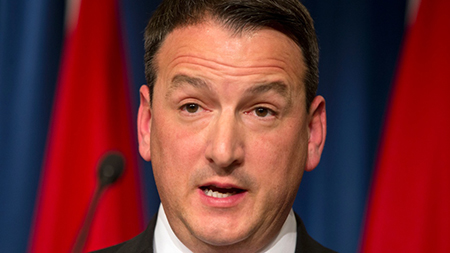CALGARY—Canada’s natural resources minister was in Texas Jan. 16 to celebrate the opening of two new pipelines that will increase the flow of Alberta crude to the United States, but said it’s “imperative” to diversify beyond that market as it becomes more energy self-sufficient.
Speaking to reporters by teleconference from the end-point of the newly expanded Seaway pipeline, Greg Rickford said the completion of that project, combined with the recently finished Flanagan South pipeline to the north, will help double Canadian shipments to the Gulf Coast to 400,000 barrels a day this year.
Rickford said the U.S. will continue to be an important customer for Canada’s oil, even as that country develops huge amounts of crude from deposits in North Dakota and Texas.
The recent collapse in oil prices to below US$50 a barrel has been due, in part, to the enormous volumes flowing out of U.S. shale deposits.
“We see new opportunities in Europe and the Pacific Basin. These are countries and markets that are have already invested heavily in our energy sector in Canada and find great appeal in the political and economic stability in Canada and obviously the abundance of the resource,” said Rickford.
“While exports to the United States remains a significant cornerstone piece of our market diversification strategy, there is no question that market diversification for Canada means creating new opportunities for new markets and moving away from an over-reliance to one single customer.”
The 600,000 barrel per day Flanagan South pipeline, operated by Enbridge Inc., runs from Pontiac, Ill., to a key oil storage hub in Cushing, Okla.
The Seaway pipeline, with a capacity of 850,000 barrels per day, funnels some of the crude from Flanagan South from Cushing to the Texas coast.
Enbridge has a 50 per cent stake in Seaway, but it’s operated by partner Enterprise Products Partners L.P.
The projects will help boost the bottom lines of crude producers, whose margins are being squeezed by low prices, Rickford said.
Federal Finance Minister Joe Oliver also stressed the need for market diversification a day earlier when he talked to a Calgary business crowd, but had a less rosy view of U.S. demand for Canadian crude.
“It is a matter of urgent national interest that we move our oil to tidewater because our only customer, the U.S., has found vast amounts of shale oil and gas and will need us less and less. If we do not access new markets our resources will be stranded and a huge opportunity will be lost,” he said.
“But more than that, the Canadian economy will suffer a major decline, which will affect every region of the country from coast to coast to coast. The U.S. economy is benefiting enormously from the shale revolution. It would be foolhardy in the extreme for us to sit on the sidelines and watch our neighbour prosper while we settle for mediocrity and decline.”
The Flanagan South and Seaway pipelines are starting up as Keystone XL, a controversial proposal that would also help connect Canadian crude to the Gulf, drags into its seventh year of regulatory limbo.
Calgary-based TransCanada Corp. feted the first anniversary of its Gulf Coast pipeline, which also runs from Cushing, Okla., to the Texas coast.
That project was initially conceived as part of Keystone XL, but the company decided to build the southern portion first while it awaited a permit for the cross-border segment.
In its current iteration, Keystone XL would cut diagonally from the Saskatchewan-Montana border to Steele City, Neb., where it would connect with the existing Keystone system.
The 830,000-barrel-per-day project would offer a more direct route for Alberta crude to get to the Gulf, but would tap into some U.S. fields as well.
‘Imperative’ to diversify crude markets beyond U.S.: Rickford
Natural Resources Minister Greg Rickford said Canadian crude producers need to move away from "over-reliance to one single customer"

























Laissez un commentaire Votre adresse courriel ne sera pas publiée.
Veuillez vous connecter afin de laisser un commentaire.
Aucun commentaire trouvé